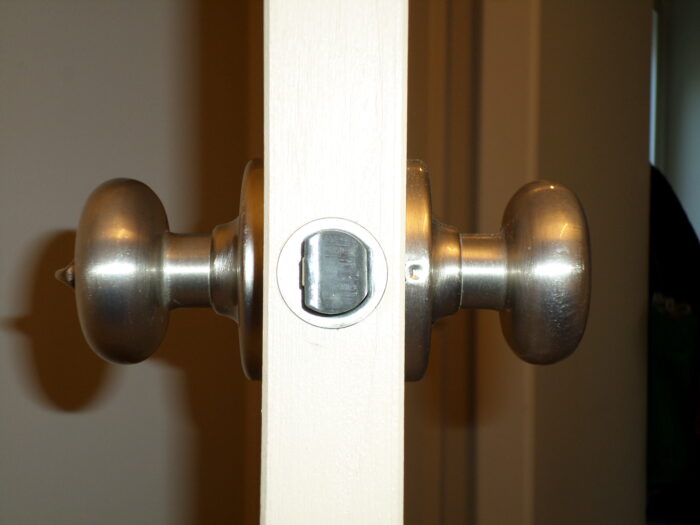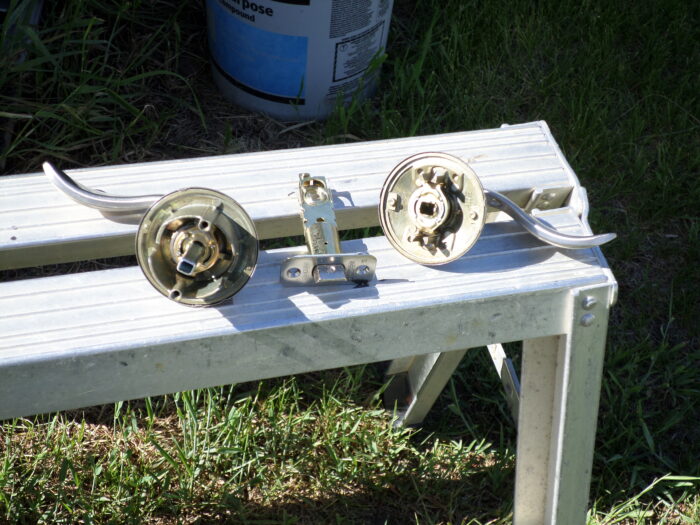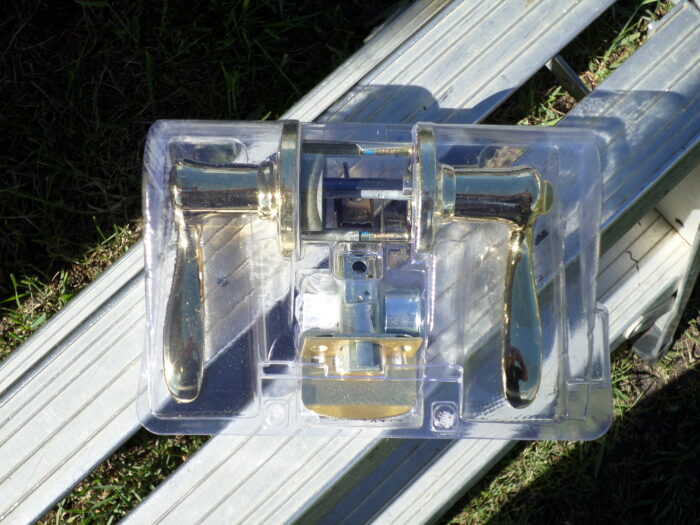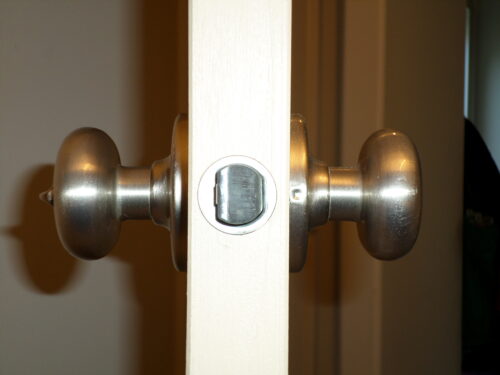Squeaking, scraping, grinding? Sounds like a cement mixer. Nope. It’s your door knob/handle. Door knobs can be quite noisy–usually after years of soundless use. And, quite often, neglect. Nothing like doing your best to be quiet at 2 AM and have the bathroom door handle sound like the doors in Dracula’s castle.
Here are some of the causes of noisy door knobs. And better yet, some inexpensive and easy fixes.
 Privacy Door Knob c/w Drive-In Backset
Privacy Door Knob c/w Drive-In Backset
6 Ways to Quiet a Door Knob
Doors and door knobs are taken for granted–until they start making noise or quit working. As with hinges and windows, door handle maintenance in most homes usually occurs too late. Most fixes are fairly easy and inexpensive.
1) Lubricate the Exterior of the Door Latch
Dry Silicone Spray is about the best door handle lubricant you can use. Inexpensive. Non-Staining. Works on almost anything. It is wet coming out of the can but after the accelerant evaporates, it will leave a slick silicone coating.
Spray directly into the backset while turning the knob repeatedly to retract and release the tongue. (Silicone spray does not stain, so if some runs out, it can just be dried off.) Also spray directly into the keyway (if there is one) and both sides of the knob where they pass through the rose cover. Try to keep it off wood or tile floor. It is slicker than goose poop on wet grass.
You can lubricate the knob as often as you like. Interior door knobs probably need a squirt once or twice a year. Exterior door knobs and handles get wet with rain or snow. Or they can freeze. Dirt and dust can blow into them. You may find that it is necessary to spray them every couple of months to keep them quiet and working smoothly.
You may also need to remove exterior knobs to dry and clean them out before lubrication. I take our north-facing handle off at least once a year to keep it clean, rust-free, and working smoothly.
Note: Do not use Original WD-40. It will dry out your lock, making it sticky. (Original WD-40 was invented as a water displacement product.)
2) Lubricate the Interior of the Door Latch
 Schlage Handle Set Removed From Door. Note Heavy Duty Barrel on Left Handle and Screw-In Backset
Schlage Handle Set Removed From Door. Note Heavy Duty Barrel on Left Handle and Screw-In Backset
If exterior lubrication does not quiet down and loosen up the door knob, you will have to take it off to deal with the interior. Most knobs are held on with 2 Philips screws, with another 2 in the backset–unless it is a drive-in backset. Inside you may find dirt, dust, rust, iron filings, filthy grease, and maybe broken parts. Clean the whole mechanism with wipes, Q-tips, and Goof-off.
Once it is completely dry, spray everything well with dry silicone. Re-assemble the handle on the door and listen to how quiet it works. Make sure that the screws are quite tight to prevent the knob moving around. (I don’t know why, but kids seem to like hanging from door knobs.)
Note: If you do find broken parts inside the handle, you may have to get a new handle. Or you may get away with just replacing the backset. (See #4 below.)
3) Adjust the Door Strike–Or Maybe the Hinges
The door strike is the metal piece on door frames that the lock tongue fits into and holds the door closed. Quite often the scraping noise you hear is the tongue dragging on the strike as the knob is being turned. Before removing the strike, drilling a bigger hole, and chiseling out the door frame, consider the following options.
- Hinges. Inspect your hinges. A 1/8″ gap between the hinge knuckles means the door has dropped that much as the hinges have worn. This is likely enough to cause the tongue to hit the strike. Change your hinges. New hinges–ball bearing if possible–will eliminate door knob scraping and hinge noise. (Ball bearing hinges are a little more expensive but do not wear like some of the cheap junk hinges we get.)
- Slab Adjustment. Replace one of the short jamb screws from the top hinge. Install a 3″ deck screw that reaches the 2 x 4 framing. By tightening and loosening that screw, you can adjust the door slab in the frame. An extra quarter inch tighter could raise the knob side of the door enough to eliminate any tongue on strike scraping.
- Grinding. If you have a small pointed grinder that fits into your drill, you can make the hole in the strike bigger. Usually you will need to lower the hole to accommodate the latch tongue. (My grinder is metal and acts like a file. Stone ones work slower and I tend to break them by putting too much pressure on them.)
If none of these work, you will have to re-position the strike. The big trick here is to mix wood glue with a little sawdust and pack it into the existing screw holes. Let dry before predrilling new holes. Your strike will stay where you put it.
For more hinge information please see our article The Best Lubricant for Door Hinges.
4) Replace the Backset
You may be hearing a crunching sound coming from your door knob. It could very well be an indication of a broken backset. Remove the knobs and backset and inspect them. The metal tails that connect the knobs run through the inside end of the backset. Knob rotation will retract the tongue allowing the door to swing open.
You may find that the end of your backset is blessed with one of the dumbest lock ideas I have ever seen–plastic parts that wear, become round, and quit retracting the tongue. Not to mention scraping and clicking when you are trying to open the door. As the saying goes, “You cannot fix stupid.” You will need a new backset.
Although there are many online sites that sell backsets, my first stop would be a lock company if you have one close by. Most of them are parts hoarders and keep almost anything they think will come in handy sometime. One of our local companies has saved me a few times–and I hoard lock and handle parts.
5) Reduce Impact
Doors that bang closed can be an indirect result of door knobs and backsets lacking lubrication. The tongues in door handle backsets are made to retract when the door is pushed against the strike. If the backset is sticking, old, not lubricated, it will not retract smoothly. If it is bad enough you will have to turn the knob to get it started. Or worse, turn the knob to retract the tongue all the way to enable you to close and latch the door.
If door handles are operating properly, gentle pressure should get them closed and latched. But unlike most exterior doors, interior doors usually do not have any kind of weatherstrip or bumpers to cushion the noise. Meaning that you have a wood door hitting a wood stop. (Or sawdust and glue masquerading as wood.)
To end these clacking noises, follow our lubrication suggestions in #1 and #2 above. If the door is hitting the frame, try using the suggestion in #3 about “Slab Adjustment”. If none of this does the trick, and you or the kids can’t get over the habit of whamming the door to get it closed, buy some stick-on weatherstrip or kitchen cabinet drawer bumpers.
Install the weatherstrip or the bumpers on the door stop–not the door slab. Weatherstrip is by far the best option to end the impact noise. And as an unexpected bonus it will reduce the noise passing through the door.
For more information please see our article 5 Ways to Stop a Door From Slamming.
6) Replace the Door Handle
 New Kwikset Lever Handle
New Kwikset Lever Handle
Door handles wear out and need to be replaced. Spend a little extra money to get a decent to good handle or knob assembly. Anything with a barrel-type arrangement that fits the hole in the door and prevents handle movement. Then even if the screws loosen up a bit the knob/handle will not slide around marking the door, sliding the backset out, or damaging the works.
You can probably find no-name handles for under $5.00. Don’t bother. Stick with something like Kwikset of Schlage that has a chance of outlasting the door.
Replacing a lockset is usually a fairly simple project–if the new one matches the old one and the holes in your door. (You don’t want to get a drive-in backset to replace one with a screw-on plate.) Many locksets come with adjustable backsets (2 3/8″ or 2 3/4″) and accessories to fit either 1 5/8″ or 2 1/8″ bored holes. And they all come with fairly detailed step-by-step instructions. Make sure you spray all the working parts with dry silicone before installing the handle. Just saves having to do it later.
Give some consideration to using lever handle locks instead of knobs if you are replacing handles. Levers are easier to open and can save banging or rubbing your knuckles on the jamb.

